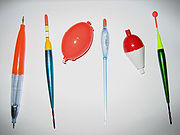
Float (fishing)
Encyclopedia

Angling
Angling is a method of fishing by means of an "angle" . The hook is usually attached to a fishing line and the line is often attached to a fishing rod. Fishing rods are usually fitted with a fishing reel that functions as a mechanism for storing, retrieving and paying out the line. The hook itself...
that serves two main purposes: it can suspend the bait
Bait (luring substance)
Bait is any substance used to attract prey, e.g. in a mousetrap.-In Australia:Baiting in Australia refers to specific campaigns to control foxes, wild dogs and dingos by poisoning in areas where they are a problem...
at a predetermined depth, and it can serve as a bite indicator. They are often used in conjunction with a fishing sinker. Fishing with a float is called float fishing.
Floats come in different sizes and shapes. They are usually brightly coloured so they are easy to see.
- The waggler is a thin tube of plastic with a line threaded through an eye at the bottom. It is commonly used as a running line float on still waters.
- The avon has a somewhat large and oval-shaped hollow area near the tip. Extra shot is added to the line so only the tip shows, allowing the line to be cast further. Avons are used in slow-flowing water.
- Long, thin floats are very sensitive and are used for coarse fishingCoarse fishingCoarse fishing is a term used in the United Kingdom and Ireland for angling for coarse fish, which are those types of freshwater fish other than game fish . The sport and the techniques used are particularly popular in the United Kingdom and mainland Europe.-History:The term "coarse fishing"...

